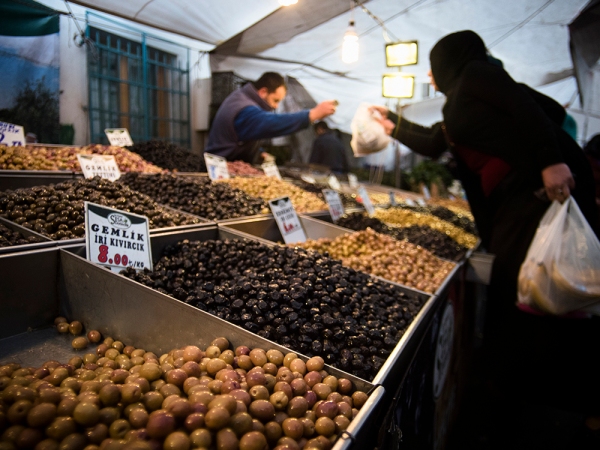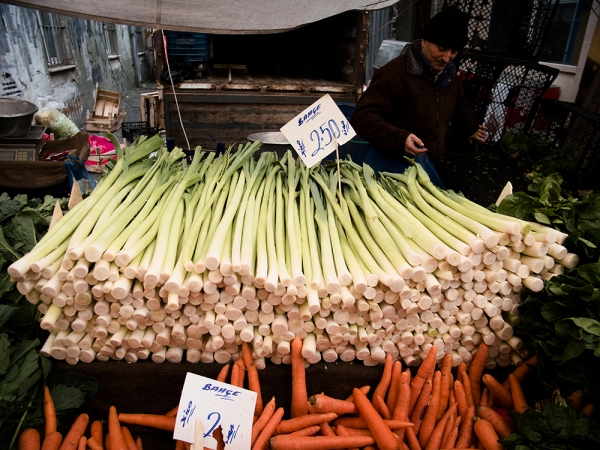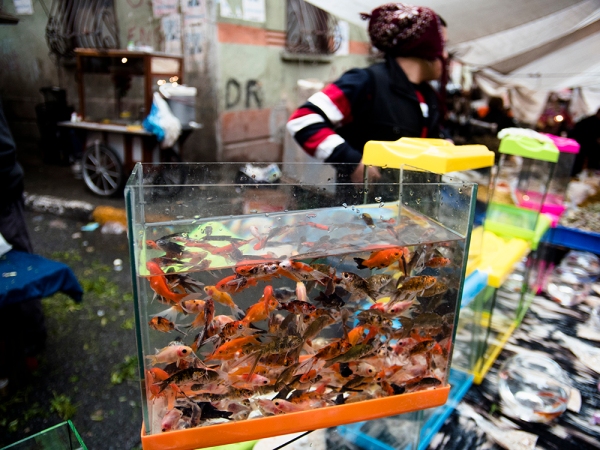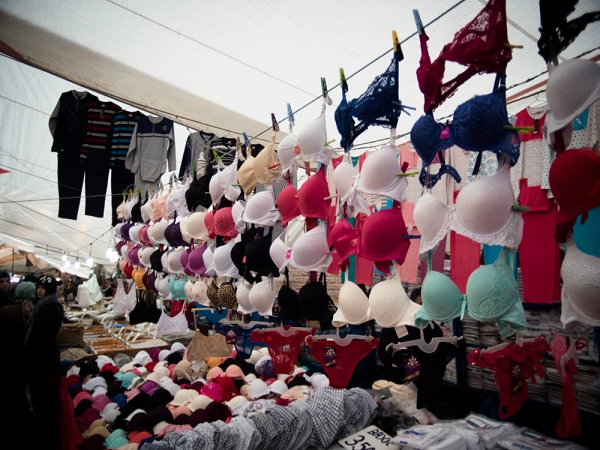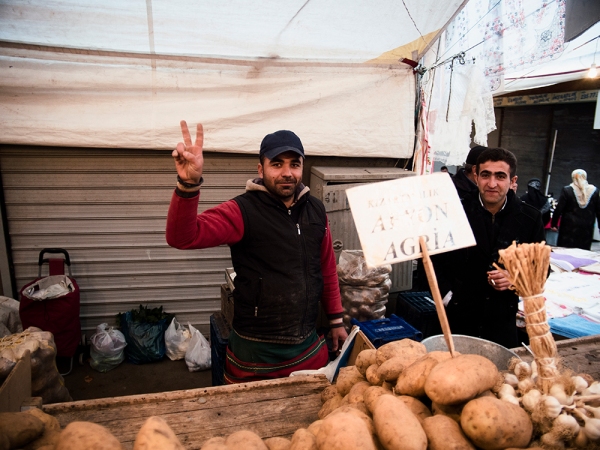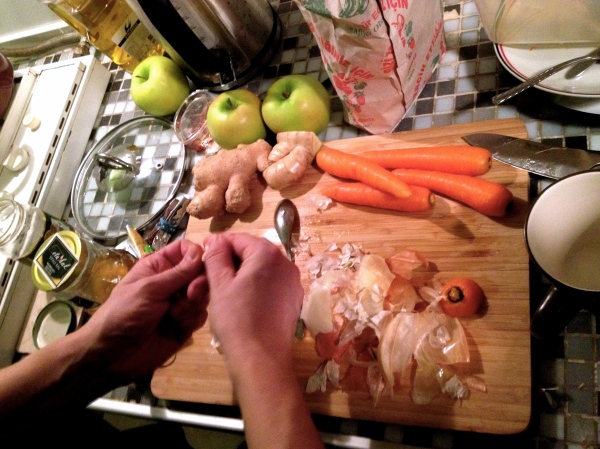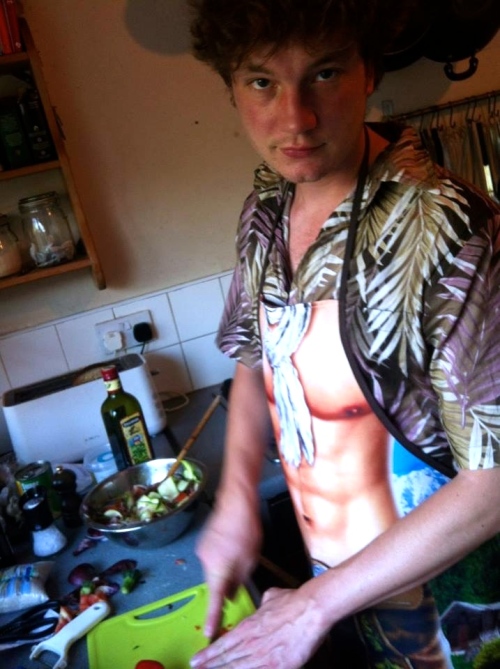Tripping in Tarlabaşı
All photographs: Oliver Zimmermann
I lurch forward suddenly with the impact of another body hitting mine. To add injury to insult, I trip over a raised piece of concrete jutting out from the pavement, stubbing my big toe. Frazzled and overladen with shopping bags, I’m propelled onward amid the herd of people funnelling into the busy marketplace ahead.
Like so many increasingly popular locations in Istanbul, Tarlabaşı is changing rapidly. Over the past ten years many previously dilapidated, impoverished, and even dangerous areas of the city like Galata, Cihangir and Karaköy are now frequented by travellers, expats, artists, students and hipsters. As a result, Tarlabaşı’s weekend market is also benefiting from an increase in popularity and regular custom from foreigners and locals alike. In fact, the whole area is predicted to soon undergo the same kind of gentrification that has transformed Galata over the past decade.
If you take a trip down to the Sunday market in Tarlabaşı you will be engrossed by a sensory banquet of colourful chaos. Central Tarlabaşı is host to one of Istanbul’s many vibrant underbellies of street trade. The magnificent mishmash of stools has much to offer and is always packed with manic shoppers, falling over one another to grab a bargain as they binge-buy.
One of the things that makes Tarlabaşı’s weekend market unique is its unpolished charm and, most importantly, its uncommonly low prices. It is not only notoriously cheap to shop here, it is also a cultural feast for the eyes and ears. You’ll be dazzled by streets brimming with mountainous piles of fruit and vegetables cascading from rickety wooden tables and lured in by the provocative cries of tradesmen advertising their wares left, right and centre.
However, despite such positive predictions regarding the regeneration of Tarlabaşı, many here fear that an unavoidable consequence of development in the area will be the necessary sacrifice its currently rugged charm and unique atmosphere. The prospect of gentrification here also poses the problematic question of what will happen to the current lower income families living there, who will undoubtedly be pushed out as food and rent prices rise. While the rejuvenation of impoverished and neglected inner-city districts is perceived—on the whole—as a good thing, there are many potentially negative connotations for residence. The wealth predicted to flow into Tarlabaşı over the coming years will naturally exclude and further oppress poor and immigrant communities in the area, forcing them to move on to less desirable outskirts of the city, where their living standards will deteriorate further. A story too often told in tales of gentrification within numerous enterprising cities throughout history.
In a time when the average Istanbulian’s wages are grossly disproportionate to the cost of living, and when food and accomidation costs are consistently rising, the Tarlabaşı market is at once a refuge to low income citizens and a bargain-hunter’s dream come true. It is now one of the best places in Beyoğlu to stock up on the essentials for your weekly food shop. You can purchase all sorts here: from the practical and everyday, to the downright bizarre.
You can buy luxury goods like spices, olives, dried-fruits and cheeses in bulk and for a much lower price than any supermarket. You can pick up other novelty items, such as miniature goldfish—sold at 5 tl a piece—in tiny glass takeaway bowls. You can also acquire a whole plethora of useful tat here: from cheap brassieres, track suits, kitchen gubbins and other brand knock-offs.
Like the range of ladies underwear available, everything at Tarlabaşı’s outdoor market is oversized and underpriced. Despite being organic and homegrown by local farmers, even the cabbages here look like genetically engineered science experiments — weighing in at a hefty 7 kilos each!
Today, Tarlabaşı is described by many as the “soon-to-be up-and-coming” place to live within the Beyoğlu district of Istanbul. The young genrtifiers of the city are now choosing to settle in Tarlabaşı, over other more trendy areas. The new community of outsiders moving into Tarlabaşı are drawn here by the low rent prices and spacious apartments available; these young Istanbulites do not see the sense in living in the grossly overpriced Cihangir or Galata when they can live comfortably in the charmingly rough-around-the-edges and characteristic, Tarlabaşı. The benefit of the local weekend market here also means that residents living on low monthly incomes can do their entire weekly food shop for under 100 tl. Therefore, like so many impoverished areas of the city, Tarlabaşı is also considered as the place to invest in property and redevelopment, before the imminent boom hits.
But Tarlabaşı is not there yet. There are still many dangers associated with living here as a foreigner. Drug dealing among the derelict back-alleys is rife and there have been numerous reports of rape and muggings after dark in the more remote areas. The high crime rates, poor living standards and low home security, mean that newcomers to the district have to wise-up fast. I have many female expat friends who live in Tarlabaşı and who have to avoid walking alone at night and habitually carry pepper spray in their handbags.
In contrast, areas like Galata have been transformed over recent years into city hot-spots, boasting multiple trendy bars, cafes, pop-up shops and art galleries. However, many residents recall a time when local mafia ran the streets of Galata. In those days Galata was rife with crime and the roads were blocked-off at night, so that even the police could not enter after dark. Yet, ironically Galata is now one of the safest, most picturesque areas on the European side of Istanbul. Tarlabaşı, on the other hand, still looks and feels relatively crude by comparison.
Today, the streets of Tarlabaşı remain murky and smell of coal-smoke. Currently undeveloped, rough-and-ready Tarlabaşı is made up of a ramshackle maze of timeworn buildings. Rubbish bins overflow onto jagged strips of pothole-riddled pavements and the roads are filled with rickety old cars. It serves as a kind of mirror of a former Galata or Cihangir, like a window into the not so distant past.
Living here may be cheap but the area is still insecure. The buildings here quite literally crumbling at the corners – not somewhere that particularly inspires confidence in light of Istanbul’s imminent earthquake. The streets are made up of cramped, jagged structures surrounding the numerous claustrophobic labyrinth alleyways. As with most built-up inner-city areas of Istanbul, there are few rooms with a view beyond another wall of concrete.
Yet, Tarlabaşı remains an increasingly desirable location to the new generation of expats and travellers in Istanbul. The streets have an alluring grittiness to them, a vibrant, yet mystifying energy. Despite a looming sense that you could have your wallet nicked at any moment, Tarlabaşı is a genuinely interesting and exciting place to explore — particularly on the weekend, when the market is in full bloom.
I for one sincerely hope that Tarlabaşı retains its quirky and exhilarating charisma as it continue to develop and evolve.
All photographs Copyright of Oliver Zimmermann http://www.oliverzimmermann.com/ and all rights reserved


